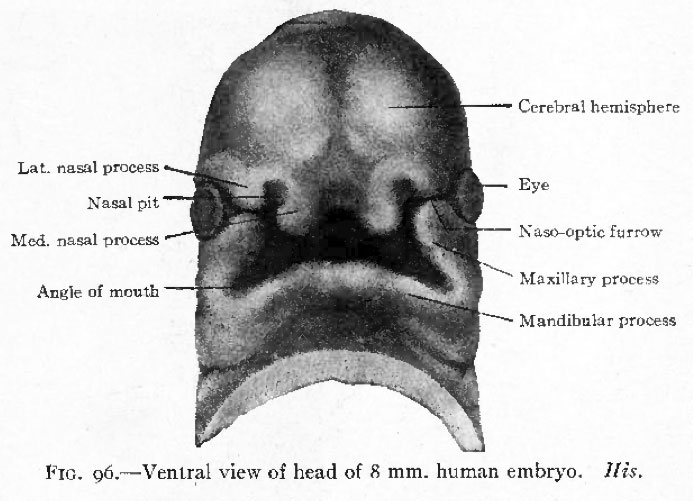File:Bailey096.jpg
Bailey096.jpg (693 × 501 pixels, file size: 59 KB, MIME type: image/jpeg)
Fig. 96. Ventral view of head of 8 mm human embryo
| Historic Disclaimer - information about historic embryology pages |
|---|
| Pages where the terms "Historic" (textbooks, papers, people, recommendations) appear on this site, and sections within pages where this disclaimer appears, indicate that the content and scientific understanding are specific to the time of publication. This means that while some scientific descriptions are still accurate, the terminology and interpretation of the developmental mechanisms reflect the understanding at the time of original publication and those of the preceding periods, these terms, interpretations and recommendations may not reflect our current scientific understanding. (More? Embryology History | Historic Embryology Papers) |
His.
Growing from the cephalic side of the arch, a strong process insinuates itself between the arch and the fore-brain region. This is called the maxillary process, while the original part of the arch is the mandibular process. The latter grows rapidly, extends ventrally and finally meets and fuses with its fellow of the opposite side in the midventral . line caudal to the oral fossa (Fig. 96). The maxillary process still bounds the oral fossa laterally. Meanwhile a broad downward projection from the front of the fore-brain region the naso-frontal process comes in contact laterally with the maxillary process (Fig. 96). Along the line of contact a furrow is left, which extends obliquely upward to the eye rudiment and is known as the naso-optic furrow.
The various structures that have been mentioned bound the oral fossa which has now become a deep quadrilateral pit. Cranially (above) the fossa is bounded by the broad, rounded, unpaired naso-frontal process; caudally (below) it is bounded by the paired mandibular processes; laterally by the paired maxillary processes. Between the maxillary and mandibular processes on each side a notch marks the future angle of the mouth. In general it may be stated that the naso-frontal process gives rise to the nose and middle of the upper lip, the maxillary processes to the lateral parts of the upper lip and the cheeks, the mandibular processes to the lower jaws, chin and lower lip.
- Text-Book of Embryology: Germ cells | Maturation | Fertilization | Amphioxus | Frog | Chick | Mammalian | External body form | Connective tissues and skeletal | Vascular | Muscular | Alimentary tube and organs | Respiratory | Coelom, Diaphragm and Mesenteries | Urogenital | Integumentary | Nervous System | Special Sense | Foetal Membranes | Teratogenesis | Gallery of All Figures
| Historic Disclaimer - information about historic embryology pages |
|---|
| Pages where the terms "Historic" (textbooks, papers, people, recommendations) appear on this site, and sections within pages where this disclaimer appears, indicate that the content and scientific understanding are specific to the time of publication. This means that while some scientific descriptions are still accurate, the terminology and interpretation of the developmental mechanisms reflect the understanding at the time of original publication and those of the preceding periods, these terms, interpretations and recommendations may not reflect our current scientific understanding. (More? Embryology History | Historic Embryology Papers) |
Reference
Bailey FR. and Miller AM. Text-Book of Embryology (1921) New York: William Wood and Co.
Cite this page: Hill, M.A. (2024, April 20) Embryology Bailey096.jpg. Retrieved from https://embryology.med.unsw.edu.au/embryology/index.php/File:Bailey096.jpg
- © Dr Mark Hill 2024, UNSW Embryology ISBN: 978 0 7334 2609 4 - UNSW CRICOS Provider Code No. 00098G
File history
Click on a date/time to view the file as it appeared at that time.
| Date/Time | Thumbnail | Dimensions | User | Comment | |
|---|---|---|---|---|---|
| current | 16:10, 18 January 2011 |  | 693 × 501 (59 KB) | S8600021 (talk | contribs) | ==Fig. 96. Ventral view of head of 8 mm human embryo== His. {{Template:Bailey 1921 Figures}} Category:Human Category:Wilhelm His |
You cannot overwrite this file.
File usage
The following 3 pages use this file:

